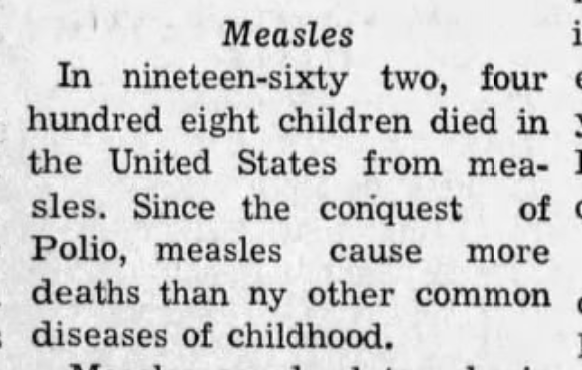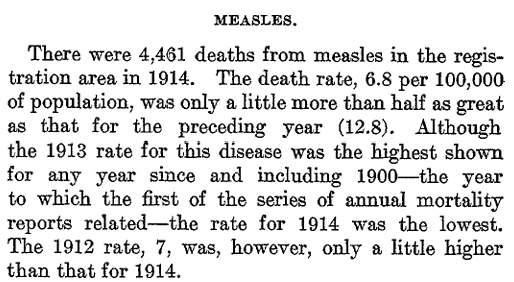 |
| Reported by USA and Canadian Outlets: Polio (with vaccine) vs Measles in USA, 1958 - 1959 |
Tracing measles isn’t just about death; it’s uncovering how the disease shaped family decisions, movements, and emotional legacies.
1. Did Measles Appear on a Death Certificate?
2. Were There Local Epidemics That Affected My Family?
3. Were Multiple Children Died within a Short Time from One Another?
4. Were Local Institutions Affected by Measles? (asylum, orphanage, military barrack, etc)
5. Did the family move to avoid an epidemic?
Measles Are Back, Cases in 2025
Note: For comparison, 16 outbreaks were reported during 2024.
1657 - 1963: They Died from Measles
Some believe tracking measles is new. It isn’t! It has been tracked for over a century. In American colonial records, the word “measles” appears by the 17th century. Early U.S. medical writings from the late 1700s and early 1800s refer to measles by name, especially in the context of smallpox and scarlet fever as childhood illnesses. Researchers will also see “rubeola.”
The first recorded epidemic of measles in what would become the United States occurred in 1657 in Boston, Massachusetts Bay Colony. It was described in colonial diaries and town records. This was among the earliest documented community outbreaks of measles in North America.
Before federal tracking, disease statistics were local or state-led.
 |
| Washington (D.C.) Gazette, Jul 19, 1823 |
Cities like Boston, New York, and Philadelphia began keeping vital statistics in the mid-to-late 1800s, mostly focused on deaths. Some State Boards of Health (like Massachusetts in 1869) published reports mentioning outbreaks
1912. The U.S. Public Health Service (USPHS) formed from the Marine Hospital Service, began requiring state and city health departments to report weekly data on ten communicable diseases, including measles. This marked the start of national infectious disease surveillance in the United States.
By 1912, over 30 states participated in reporting to the Weekly Morbidity Reports, later known as the Morbidity and Mortality Weekly Report (MMWR). Measles was responsible for 6,063 deaths in registration states the first year of 1912. This information was found in the Vital Statistics of the United States, 1912;" published by the Bureau of the Census;" published by the Bureau of the Census. This annual report includes mortality tables by cause of death By 1933, all states were included in national death statistics.
11 Diseases reported in 1912 on the Ancestors
- Measles
- Smallpox
- Typhoid fever
- Diphtheria
- Tuberculosis
- Scarlet fever
- Pertussis (whooping cough)
- Poliomyelitis
- Meningitis
- Cholera
- Influenza (1918)
Across the Pond: England. The USA was late. England had begun reporting the statistics of this disease as early as 1895.
In 1962, 408 children in the USA died of measles. This was the year before the vaccine.
 |
| The Daily Democrat, May 08, 1965 |
1963. The measles vaccine was licensed in the U.S. in 1963. There was a national campaign to stop the deaths;

Figure 2 The Daily Democrat, May 08, 1965, Lamar, MO
2000. By the year 2000, measles was declared eliminated (no continuous transmission) in the U.S., though outbreaks have occurred due to imported cases and vaccine hesitancy.
7 Resources for Measles Research
- Coroner records
- Death certificates
- Obituaries printed in local newspapers,
- Journals / Diaries,
- Doctor notes that allow us to identify not only epidemics but also which of our ancestors died from Measles Check out State Archives for historical medical records
- 1880 Federal Census, "Sick" column; confirmed by one of the above
- 1850 -1880 Mortality Schedules. I will write later how these records can also be used for researching enslaved persons
 |
| 1870 Plaquemines, Louisianam Mulatto, Des Roches Family |
These schedules listed those who had died in the year preceding the census. There were also some state censuses in 1885 that included mortality schedules, specifically in Colorado, Florida, Nebraska, New Mexico, North Dakota, and South Dakota
Communicable diseases aren't reported as a grouping in the Federal Census, but researchers may uncover 1880 Federal Census "Sick" notes.
 |
1880 United States Federal Census, Kentucky Sisters: Chella and Lydia Smith |
When you are told that there is no way to know how many died of measles in the past, I hope these easily accessible CDC reports come to mind: Visit the MMWR Weekly Reports Archive CDC’s Morbidity and Mortality Weekly Report (MMWR) Archives
 |
| Mortality Statistics, 1914 |

















